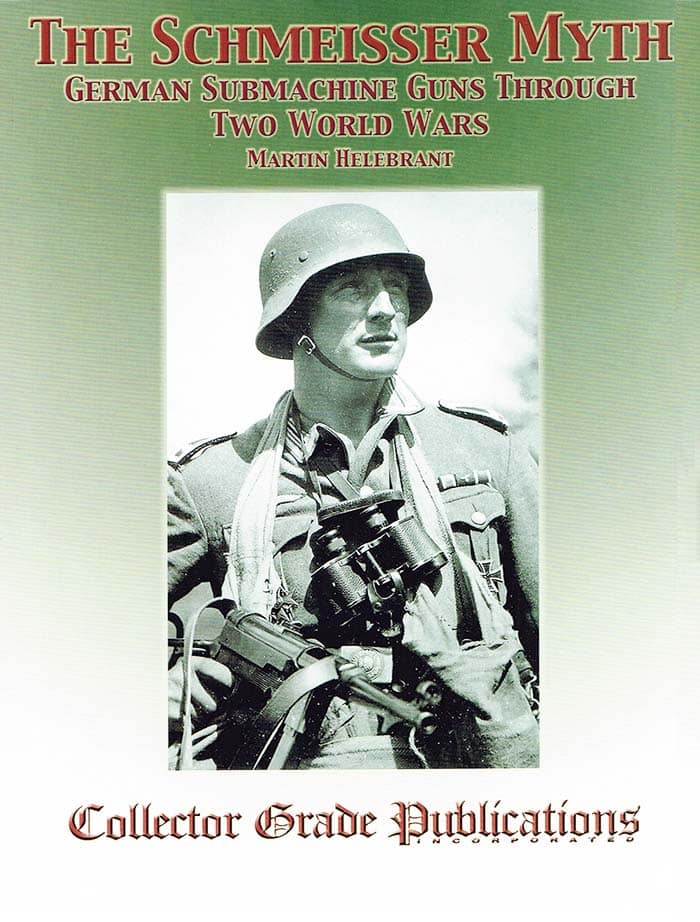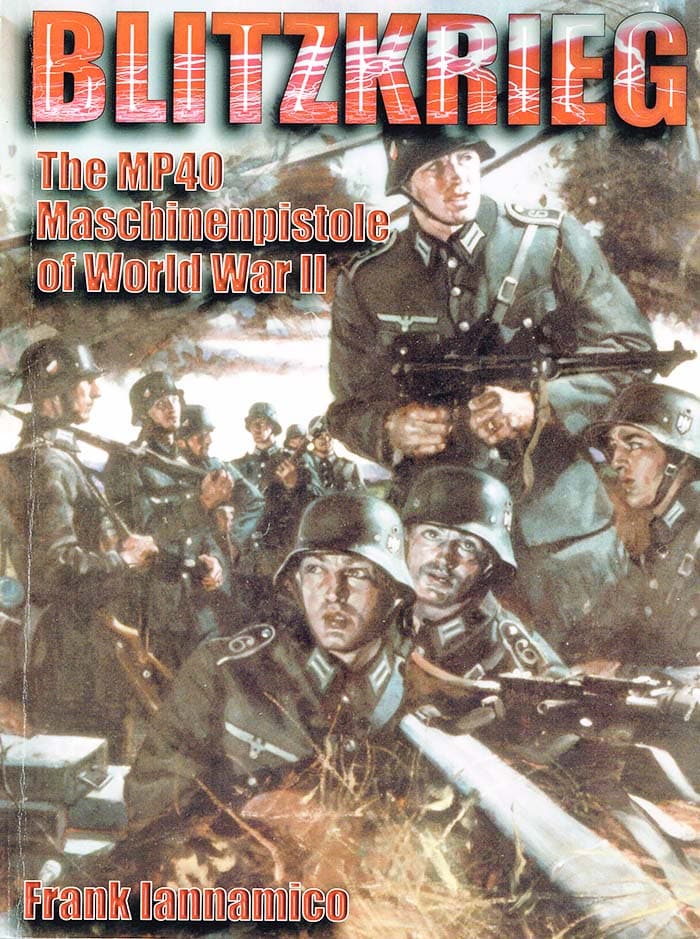By Dean Roxby
This review looks at two books from different authors that cover one subject—the legendary German MP40 submachine gun, as well as the earlier MP38 and other early German subguns.
- The Schmeisser Myth – German Submachine Guns Through Two World Wars by Martin Helebrant, from Collector Grade Publications (2016)
- Blitzkrieg: The MP40 Machinenpistole of World War II by Frank Iannamico, published by Chipotle Publishing, LLC (2016)
A quick note on the name “Schmeisser.” While German weapons designer Hugo Schmeisser did invent the first German Machine Pistol (the MP18,I), he did not design the MP38 or MP40. Apparently, upon capturing an MP38 early in World War II, the British described it as “being of the Schmeisser principle.” The U.S. military also made the same error, resulting in the MP40 becoming (incorrectly) known as the “Schmeisser” ever since.
The Schmeisser Myth – German Submachine Guns Through Two World Wars

- Author: Martin Helebrant
- ISBN: 0-88935-587-8
- Copyright Date: 2016
- ePub or PDF Download? No
- Binding: Hardcover, with dustjacket
- Size: 8.5x11in
- Pages: 432 pages
- Color/B&W Photos: 507 illustrations, in both color and B&W
- Publisher Address: Collector Grade Publications, P.O. Box 1046, Cobourg, Ontario, Canada K9A 4W5
- Website: collectorgrade.com
- Available Through: Publisher or Chipotle Publishing’s website
- Cover Price: USD $89.95
This book is another fine quality reference book from Collector Grade. It examines the history, development and heritage of the iconic MP38 and MP40 German submachine guns. These two guns are commonly grouped together due to the MP40 being essentially a simplified variant of the earlier MP38. The MP38 was made by old-world machining methods, while the MP40 used sheet steel stampings for the receiver tube. From a distance they look the same, but with a closer look the differences are obvious.
Starting with a look back to the days of trench warfare during World War I, author Martin Helebrant explains the rationale for a small, portable, quick-firing gun for use when storming Allied trenches. The first gun purpose-built to be a light, portable submachine gun was the MP18,I. Designed by Hugo Schmeisser and built by Bergmann, the MP18,I is a simple blowback design and uses an unlocked breech, firing from an open bolt rather than a more complex locked breech approach. This is possible with a low powered pistol round.
In late 1917, the German Army ordered 50,000 Bergmann MP18,I guns. These were first given to the elite Sturmtruppen (“storm troopers”) units. It soon got the nickname Kugelspritze—literally “bullet sprayer.”
Part II, Chapter Three looks at several other prototype guns from the postwar era, as does Chapter Four, “A New Era Begins.” This covers the 1925 and 1926 trials at Kummersdorf, south of Berlin. The purpose was to choose a new submachine gun to re-arm Germany. Neither the 1925 or 1926 trials produced a clear winner. Various designs from German arms firms Haenel, Rheinmetall and Vollmer were submitted. The Haenel MP28,II was designed by Hugo Schmeisser, and was an improved version of his earlier design.
Chapter Five, “The Final Forerunners,” looks at the ERMA EMP 36 and the Schmeisser-designed, Haenel-built MK36,II. The Haenel MK36,II seems to be a step backwards as it has a nearly full length wood stock, comparable to a K98k rifle. The ERMA EMP 36, by contrast, is what an SMG should look like. In fact, it looks very much like an MP40. It has the same style underfolding stock and a freestanding pistol grip. Minor differences are the main part of the stock is wood (the MP38 and MP40 use bakelite, the first plastic) and the magazine well extends at an odd angle from the receiver. There are only two surviving examples of the EMP 36 known to exist. The one featured here is from a museum in Prague, Czech Republic. The other one is privately owned by a U.S. collector.
Part III is where we first meet the guns so famously linked to Nazi Germany. This section details the adoption of the MP38 in the early days of the war, primarily feeding problems with the magazine. The issue was resolved by pressing ribs into the sidewalls of the mag to reduce drag on the rounds.
Part IV, “The Technical Aspects,” covers topics such as production numbers by month, and by the three factories that built them. The five major variants of MP40 are also described and pictured. Speaking of photos, many are in color. Primarily, these are the studio quality photos of guns from museums and private collections. The majority of Collector Grade titles are entirely black & white, so these color photos are a welcome addition. Naturally, the photos from World War II are all in black & white, as expected. Chapter 14, “A Technical Description,” includes numerous section drawings and disassembly photos. Detailed close-up photos of receiver markings show off the many numbers, letters and symbols typically found on German military guns.
Part V, “Accessories and Ancillaries” examines all the bits and pieces that make collecting military arms so interesting. Magazines, mag pouches, sling, and manuals are the natural, expected items, but this book also includes magazine loading tools, special rectangular brushes for cleaning the inside of the magazines, early flip-up steel muzzle caps, later rubber shoot-thru muzzle caps, a special winter trigger for use with heavy mittens and several types of firing pin protrusion gauges. Guest author Arnt Ove Nedrebø explains all there is to know about MP40 magazines in Chapter 16, while guest author Alex Cruiming covers the many types of mag pouches in Chapter 17. He also covered various manuals in Chapter 18. Many of the items shown here are from the personal collections of Michael Heidler, Alex Cruiming, Arnt Ove Nedrebø and Folke Myrvang.
Part VI, “Finale,” looks at the postwar use of the MP38 and MP40. Following the end of World War II, many countries put captured German equipment into service in their own military and police forces. These countries include Austria, Czechoslovakia, Finland, France, Israel, Norway and others.
As we have come to expect from Collector Grade, this book is well researched, detailed and nicely presented. Highly recommended.
Blitzkrieg: The MP40 Machinenpistole of World War II

- Author: Frank Iannamico
- ISBN-10: 0-9701954-9-4
- ISBN-13: 978-0-9701954-9-4
- Copyright Date: 2003, Second Edition
- ePub or PDF Download? No
- Binding: Softcover
- Size: 8.5x11in
- Pages: 279 pages
- Color/B&W Photos: Many B&W images
- Website: chipotlepublishing.com
- Available Through: Chipotle Publishing’s website
- Cover Price: USD $29.95
This title, from prolific military author Frank Iannamico, covers not only the history and development of the MP38 and MP40, but it also deals with the civilian care and use of these iconic arms.
It starts out a bit differently from other weapon books by stating, “This book differs somewhat in that it not only covers a history and development of the weapons, but also describes the weapons as they relate to today’s shooters and collectors.”
Chapter 1, “Introduction,” then gives a brief rundown on how to purchase a full auto firearm in the U.S.A. This is followed by a short history lesson, “Germany 1918-1939 A Brief History of Events.” Looking back to the end of World War I, the Treaty of Versailles, the ruin of many German arms firms, the rise of Adolf Hitler and the re-arming of Nazi Germany are discussed.
Chapter 2 covers the evolution of pistol cartridge carbines from merely a smaller gun with shorter wood stock, such as the MP28.II, to the folding metal stock design. The ultra rare “missing link” EMP 36 is covered here. It is interesting to note that there are only two known examples of the ERMA EMP 36, as noted in my The Schmeisser Myth review. That one is serial number 001, and is at a military museum in Prague, Czech Republic. The one featured in Blitzkrieg is the other survivor, and is serial number 014. It is quite intriguing to be able to see the only two left. Author Iannamico wrote a more detailed article for SAR on this very gun. It originally belonged to Reichsmarschall Hermann Göring himself! See smallarmsreview.com/display.article.cfm?idarticles=3451 for article.
Chapter 3 is titled “The MP38, Stepping Stone to the MP40.” It gives the history of the ERMA-designed MP38. Several clear close-up photos of the heavy, machined receiver are shown. The machined flutes running parallel on the receiver are the easiest way to tell the MP38 and MP40 apart. These are clearly depicted. Besides the current close-ups, a nice selection of World War II-era photos is included.
Chapter 4 is the longest chapter at just over 100 pages. It gives detailed views of the receiver, magazine housing, internal parts, etc. It also covers topics like Waffenamt marks, different minor variations, the three prime contractors (Erma, Steyr Daimler Puch and C.G. Haenel.), as well as the provenance of one particular gun captured in August of 1944. The chapter ends with a reprint of an English language (U.S. military) manual.
Chapter 5 looks at various accessories for the MP38 and MP40 guns. Items range from mag pouches and original manuals, to mag loading tools and the extremely rare blank firing attachment, among other items. Many of the guns and accessories shown in Chapters 4 and 5 are from the personal collections of Michael Free and the late Lou Pacilla.
Chapter 9, “Firing the Weapons,” compares and contrasts various submachine guns. It is noted that the folding stock design of the MP38 and MP40 has a lot of looseness or “play” that allows for a lot of vibration while firing. The older, wood stocked German submachine guns do not exhibit this. The firing rate is also noted, with the German guns being somewhat slower than the U.S. Thompson, and the Russian PPD-40 and PPSh-41 being much faster.
While this book is not as detailed as the Collector Grade book The Schmeisser Myth, it is a lot of book for one-third of the cost. If you can do without monthly production charts and reprints of German language correspondence, etc., this book is well worth considering.
| This article first appeared in Small Arms Review V25N8 (October 2021) |











